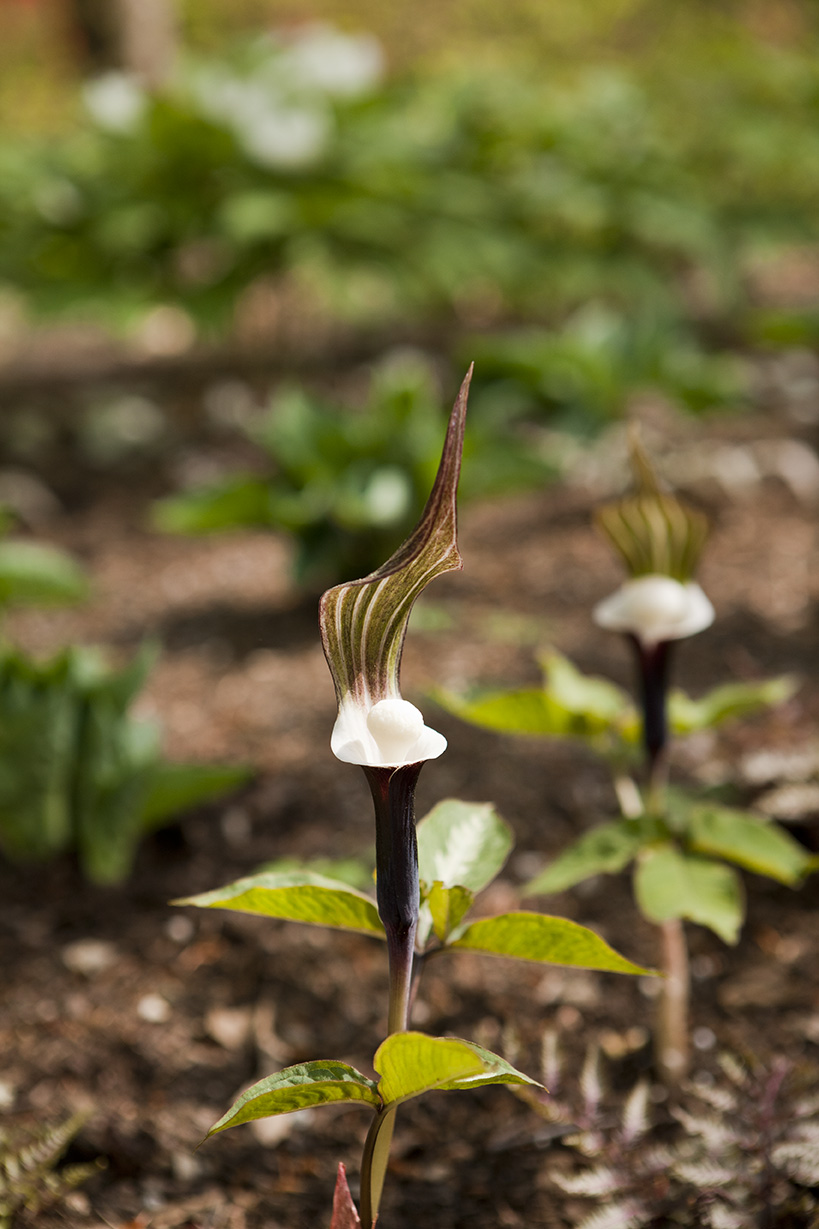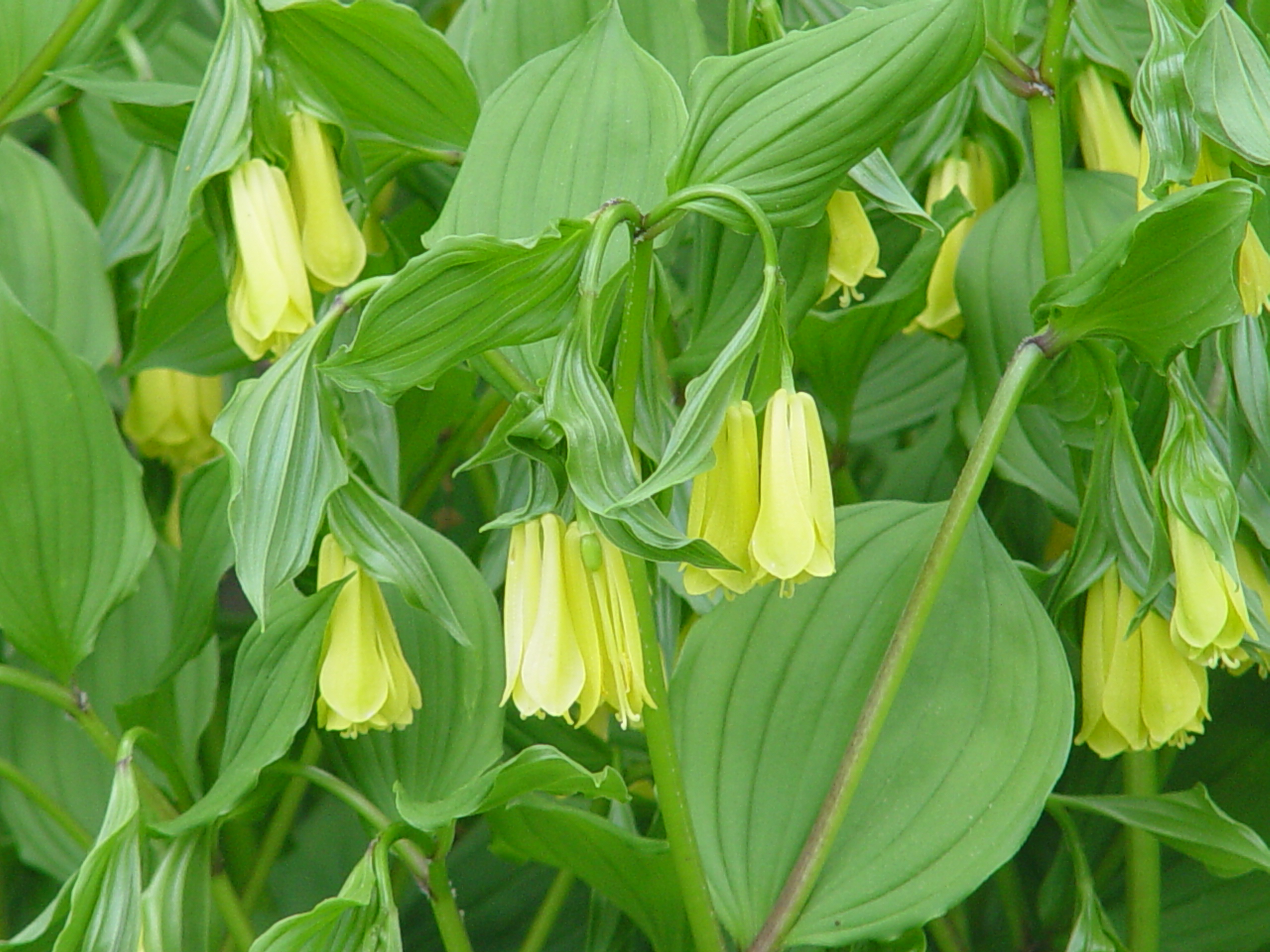Geographic Diversity in the Azalea Garden: Arisaema, Disporum, and Podophyllum
Posted in Gardening Tips on June 2 2011, by Sonia Uyterhoeven

As you stroll through the Azalea Garden you will see a large number of North American native species and their closely related Asian cousins. Many of these plants share a genus, but have different species names. For example, the garden contains many interesting Asian Arisaema commonly known as Jack-in-the-pulpits.
In botanical nomenclature, plants are identified by a two-part, or binomial, name. A plant’s genus denotes that it belongs to one group, while the species name marks it as a member of a sub-group of the genus. There are many Arisaema in the world, yet Arisaema triphyllum refers solely to a specific Jack-in-the-pulpit, one of North America’s native Arisaema.
Why are there so many closely related species on two continents separated by a large ocean? Many of these Asian/North American counterparts come from a common genetic pool. It is possible to imagine that over time seeds have been dispersed by glaciers, wind, birds, or other animals. While this certainly has occurred it would be more likely to have happened on a contiguous landmass.
The most compelling theory for why these closely related floras are found on the opposite sides of an ocean comes from the scientific theory of continental drift, the process by which the continents have moved apart over millions of years. About 250 million to 65 million years ago, during the Mesozoic era, the landmass Pangaea began to split apart; the northern part of the supercontinent broke off into Laurasia (North America and Eurasia). As Asia and North America drifted away from each other, the plants that had been one genus began to evolve. Time, combined with changes in climate, and range fragmentation helped these once related plants to diversify and evolve into new species. Why are there so many Asian Arisaema compared with only two Arisaema native to North America? During the last ice age, parts of eastern Asia remained ice-free. This resulted in a greater diversity in the flora there.
How do botanists know that these plants are closely related? Just looking at the plants can be deceptive, so they also collect evidence from the fossil record and analyze the plants’ genes in order to determine relationships.
In this video Kristen Schleiter, Curator of Outdoor Gardens and Woody Plants, discusses many of the Azalea Garden’s geographically diverse perennials.
Here’s a closer look at some of the plants in the Azalea Garden.
Arisaema
The two species of Jack-in-the-pulpit native to North America, Arisaema triphyllum and Arisaema dracontium, thrive in moist to wet soil. Asian Arisaema also enjoy moisture, but unlike the North American natives, require good drainage. All Jack-in-the-pulpits are well suited to a woodland understory, flower in spring, generally produce red berries in fall, and are deer resistant. The common names of Arisaema–Jack-in-the-pulpit and cobra-lily–refer to the unique morphology of these plants; some look like a little preacher on his pulpit, while others look like the infamous snake. The plant is composed of a spadix and a spathe. The spathe is the leaf-like hooded bract that can be seen as a pulpit or cobra’s hood. The spadix is the flower, it is the spike-like thing that pokes out of the spathe, in other words, it is the Jack.
Arisaema consanguineum ‘The Perfect Wave’ is an adaptable cobra lily that can grow in sun or shade, moist or dry. This cultivar reaches close to 3 feet tall with blue-gray foliage; the coloring is more pronounced in the shade. The hood, or spathe, ends in a long, dangling thread.
Arisaema fargesii is easy to grow with its giant trifoliate leaves opening in early spring and the flowers appearing in June. The dramatic wine-colored and white-striped spathe looks like a cobra head with a reddish spadix poking out like a narrow tongue.
Arisaema sikokianum is probably the most sought after species on the market. It has handsome foliage: each leaf has three or five leaflets that are often mottled with silver. The spadix looks like a jumbo cotton swab that emerges from a deep-purple spathe. It is a startling and striking combination, flowering in early spring.
Arisaema urashima grows 15 inches tall, and its foliage looks like a horseshoe with 11-15 narrow leaflets radiating outward. The spadix on this Arisaema looks like a whip that extends well past the spathe. The spathe is maroon with a speckled white base.

Disporum
The Azalea Garden also includes two Asian fairy bells (Disporum).
Disporum cantoniense ‘Night Heron’ is a cultivar that emerges with chocolate-brown foliage in spring that fades to a chocolate-green in summer. It can reach 4–6 feet tall and looks more like a dancing bamboo than a fairy bell. Later in the season fairy bells are covered with black berries.
Disporum flavum, is a yellow fairy bell from Korea that looks similar to Solomon’s seal (Polygonatum), growing 30 inches tall and producing creamy-yellow nodding, bell-like flowers.
Podophyllum
Mayapples present another example of plant diversification from Asia to North America.
Podophyllum hexandrum ‘Majus,’ the Himalayan Mayapple has the typical, broad umbrella-shaped foliage of the North American native mayapple, Podophyllum peltatum. P. hexandrum comes with an added bonus of black-and-purple marbling and lovely pink-white, upward-facing, cup-shaped flowers in May.
Podophyllum pleianthum is another Asian mayapple. It is a taller, glossier, larger-leaved version of P. peltatum, reaching 2 feet tall with 13-inch-wide foliage. Mayapples are deer resistant.

